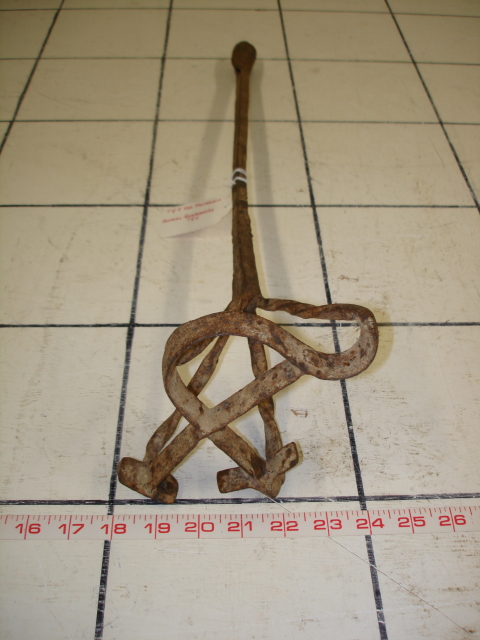This hand-forged branding iron consists of the letters “L” and “S” which is believed to have been used at the La Sirena (Spanish for The Mermaid) Ranch in Mexico. Cattle brands such as this one are used by ranchers to brand their livestock. In order to brand calves two cowboys, referred to as flankers, restrain and position it for branding. The glowing, hot branding iron is placed on the calf’s hide momentarily. The heat of the iron burns the brand into the hide of the calf.
Branding cattle distinguishes one’s ownership over certain cattle. This was highly important for ranchers since there were no fences in the West to distinguish one’s property from another. Barbed wire that was sturdy enough to contain livestock was not invented until 1873. This invention offered an affordable way for large areas of land to be fenced in. Many ranchers chose to fence off their ranch land with barbed wire to keep their cattle from wandering. However, not all ranchers wanted to fence off their land. Even now, much of the ranch land in Texas remains open range, meaning that the cattle are free to roam and are not confined to a certain area through the use of fences.
In 1504, Hernando Cortés reached the New World, and by 1518 he set out on a mission to secure the interior of Mexico. On his way to Mexico, Cortés brought along his cattle that bore burned crosses on their hides to distinguish them from other herds. The tradition of branding cattle caught on with Mexican cattle ranchers and spread northward as the cattle industry moved into Texas. Early Mexican ranchers typically used abstract symbols for their branding iron designs but later shifted to using initials. Current branding irons can be made up of symbols, initials and numbers.
Branding iron designs are decided upon by the rancher and are typically read from top to bottom, right to left or outside to inside. In the cattle driving era, cowboys carried small brand books that were filled with all of the brands of local herds. These brand books assisted the cowboys at roundup time in returning stray or stolen cattle to their owners. Once government regulations gained stronger footholds in the West, ranchers filed their brands with their county land offices and courthouses. Today, branding iron designs used in the United States must be legally registered. Modernization of the cattle ranching industry has resulted in the abandonment of traditional branding irons, like the one from La Sirena, in favor of electronic ear tags.
Cattle ranching has played a major role in Texas’ economy since the 18th century when herds were brought into the San Antonio and Goliad areas to feed missionaries and soldiers. After this period, cattle ranches became privately owned enterprises. By the early 19th century, cattle ranches were widespread in Texas which was, at this time, part of Mexico. By 1836, Texas gained its independence from Mexico and claimed the herds of cattle that remained on their land. Texas has since had larger numbers of cattle than any other state (the all-time high was nearly 11 million head of cattle in 1968).
